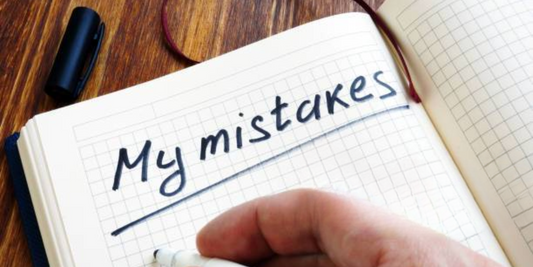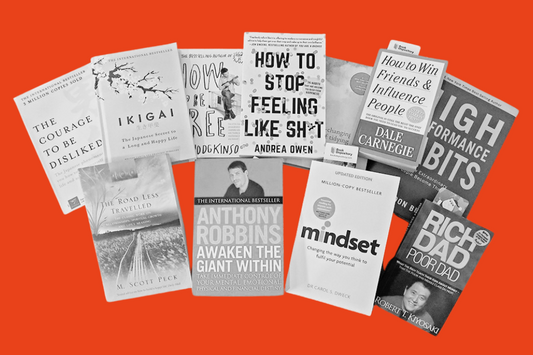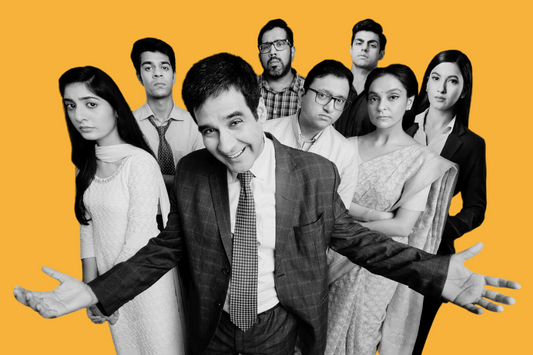If you like slow-paced movies without the excessive drama, then Netflix’s Good Grief is just the right film for you.
Now, I must reiterate that I am not reviewing the movie because I didn’t feel a strong pull in either direction - you’ll find multiple thought pieces on the internet each telling you why they think it’s a good (or a bad) film - but sadly, this is not one of them. My feelings about the movie are pretty neutral; it wasn't a movie that intrigued me, but it also left me looking beyond the basic storyline, plot, and acting. However, I did want to talk about how the movie addresses the concept of grief from a metaphorical perspective.
Good Grief is about a man (Marcus as played by Dan Levy) mourning the loss of his husband as his two best friends (Himesh Patel as Thomas & Ruth Negga as Sophie) help him on his journey of grief and acceptance. The first thing that caught my attention after I finished watching the film was how slow and ‘uncomfortably below neutral’ it flowed. My discomfort was what piqued my attention. Yes, I like the occasional adrenaline-pumping experience when I am watching a blockbuster, but in general, I find myself being drawn to plots that simmer and stew - the quintessential slow burn. It made me think of how grief is usually the elephant in the room - heavy and all-consuming, but also making everyone want to get out of the room as soon as possible and “move the d@mn on”. Even though I didn’t overtly empathise with the grieving in the movie; I found myself waiting for the moving-on part to hit…. but it didn’t. There were no dramatic scenes. Even the meltdowns seem muted.
It made me think of how grief manifests in real life.
We hear how it always comes through in tides and waves; imagine a tsunami of tears preceding calm, moving waters. But the movie did away with these obvious representations. Instead, there were almost tiny ripples hidden beneath very mundane behaviours. I like to see grief as a strong undercurrent. Mostly because we can predict it, know that we can’t fight it, and realise that it is inevitably a part of life. We can use distractions - avoidance, anger, etc. - to ensure we don’t drown, but the more we don't confront it the more we sink into it.
Though the movie focuses on the main character and his grief, we can see how each of the three characters confront their own lives and what they are left grieving. When we hear people’s narratives about their grief experience, we always hear it in a more individual emotionally isolated experience, but in reality, grief is among the multitude of emotions that simultaneously show up with overlapping situations and interactions.
The most conventional way to look at grief is through the five-stage model - denial, anger, bargaining, depression, and acceptance. However, even though this is a very structured way to explain grief and its phases, grief isn't usually this linear or clear-cut. It is more messy and chaotic, as all emotions tend to be. Even in The Bear, we see how complex grief is as an emotion and how Carmen deals with a whole gambit of loss all at once, and not a single instance of it follows any of the structure we’ve all grown to learn. It can all be quite deafening.
In fact, that’s something the film gets right about the essence of grief - it shows us how loudly and softly we experience loss. I know it sounds like a contradiction, but just think about it, as we grapple with the idea that we will never experience the person that we loved again and what that means to us and our life ahead, we are also silently living the motions of this life every day. In her book “The Grieving Brain”, Mary-Frances O'Connor talks about how grief is a form of learning. She says that our brain encodes a relationship and we function with the knowledge that even though we are away, the people that we love would be around and in sight when we want to reach out to them, but when a loved one dies, we are grappling with the idea that they still exist in our mind but they do not exist in time and space. Every day we register our loss, we learn to live without. For those who are grieving, the reality is that this is done alone.
Collectively we tend to avoid talking about loss, because of the feelings that come up, because of the crying, the varied thoughts, and also because of our constant internal monologues that ask us “What can one do about it anyway?”
The loneliness of the journey of grief is beautifully portrayed in the movie through the kind of conversations the characters have and the ones they also don't. There are moments of vulnerability, anger, and confusion, moments of a lot of feeling (and barely any talking). Marcus’s friends are there for him, but the conversations don't often include details about his spouse or a deep dive into his feelings.
Good Grief introduces us to a world of normal grieving.
The reality is that when we face loss, we face our helplessness and lack of control and this is not just about the circumstances, this is within ourselves, as well. I would personally like for life to immediately go back to normal, but the post-loss normal is not the usual normal, it is often interjected with bouts of grief, anger, confusion, fear, and the eternal “Will it ever be the same again?”
Here, all three characters are dealing with their versions of grief, yes, but it’s a non-conventional-looking grief. We see Marcus coping with grief the conventional way, especially when he has the support of his friends. But then, the unconventional grieving starts right after. Opening his recently deceased husband's Christmas card leads him to go through a bulldozer kind of disillusionment, which stirs up a full array of suppressed emotions. All this reaches a point where he almost starts grieving his relationship and confronting things that he suppressed by using the relationship as a metaphorical bubble.
Sophie, much like Marc, is also very avoidant about her feelings and situations that elicit her to confront her own emotions. She reminds me a lot of a person who spends all their time splashing and thrashing around in the water but refuses to want to feel the ground. In her case, Sophie swings from one high to another, sabotages herself, and refuses to pause - only so that she can avoid all the feelings that might pop up in the first place. Her grief looks very different from Marc’s - it almost feels like she is grieving growing up. After all, growing up would mean having to be responsible and look at reality once the distractions are not blurring things out.
And then there is Thomas, who like Marc and Sophie before him, is very high on avoidance. He is unwilling to confront reality and grieve all the rejections he felt throughout his life. He seems to have this incessant need to control and be the ‘most responsible, most good, most fine, most put together, most even-keeled’ out of the three of them. Which is a way to keep him from confronting his emotions.
If you ask me, I think the movie should have been called Good Avoidance, only because it seems more apt. Grief, since it is such a weighted emotion, is the most universally avoided feeling. I think the movie highlighted the internal and external confusion when it comes to many emotions. Since, in most instances, conventional grief catches us by surprise, it stirs the pot of other avoided feelings. In the movie, it is almost like the final straw that broke the camel's back and urged the three of them to confront their metaphorical straws (uncomfortable suppressed emotions).





